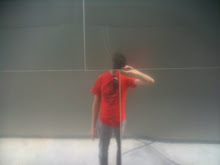When I listen to Menomena, I feel as if I am stepping outside of time. Rather than looking around to hear what is trendy or looking backwards to a former golden era of psych, vocal harmony, or classic rock, Menomena make music that is uniquely their own. I don’t mean to say that they have created music in a vacuum, that they have no influences. Nor do I mean that they defy genre classification. There is no question that Menomena make pop music. But when I try to place them in time, to categorize their sound and place them firmly within a more specific context, I fail. And this is what makes them one of the most exciting bands playing pop music today.
I heard Menomena play once at the Crocodile in Seattle, in February 2007. They were touring on their second album Friend and Foe. The show was great – their songs played loose and energetic. Even my very picky wife enjoyed the show. Menomena kicked off their tour for their third album Mines just two days ago here in Seattle. Sadly I missed it. But for the rest of you outside of the Pacific Northwest, you may have a chance to see them perform live, and I highly recommend you go.
Mines does not break new ground. But that doesn’t mean it follows any previous forumula. Still here are piano, electric guitar, saxophone, drums, and the voices of every band member. The quality of the latter is another aspect that makes this band stand out. I am not in love with any of the voices, but I find it refreshing that they sound like average dudes that can sing well. They don’t sing in falsetto, nor do they harmonize a la The Beach Boys (and so many of the popular indie bands of the past 4-5 years). This is what I like about them, and what makes them stand apart from the popular music of the day.
Check out their mini-video of "Dirty Cartoons", starring a homeless mime-drummer.
